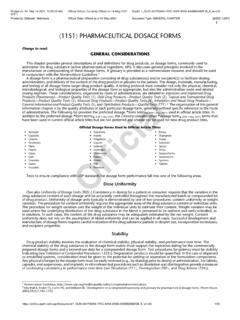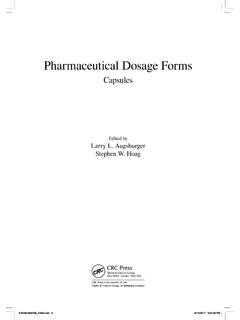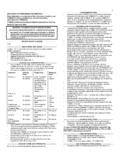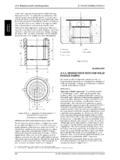Transcription of PROPOSAL TO WAIVE IN VIVO BIOEQUIVALENCE …
1 Working document page 1 WORLD HEALTH ORGANIZATION ORGANISATION MONDIALE DE LA SANTE PROPOSAL TO WAIVE IN VIVO BIOEQUIVALENCE REQUIREMENTS FOR THE WHO MODEL LIST OF ESSENTIAL MEDICINES IMMEDIATE release , SOLID ORAL dosage FORMS World Health Organization 2005 All rights reserved. This draft is intended for a restricted audience only, the individuals and organizations having received this draft. The draft may not be reviewed, abstracted, quoted, reproduced, transmitted, distributed, translated or adapted, in part or in whole, in any form or by any means outside these individuals and organizations (including the organizations concerned staff and member organizations) without the permission of WHO. The draft should not be displayed on any website. Please send any request for permission to: Dr Sabine Kopp, Quality Assurance & Safety: Medicines (QSM), Department of Medicines Policy and Standards (PSM), World Health Organization, CH-1211 Geneva 27, Switzerland.
2 Fax: (41-22) 791 4730; e-mails: The designations employed and the presentation of the material in this draft do not imply the expression of any opinion whatsoever on the part of the World Health Organization concerning the legal status of any country, territory, city or area or of its authorities, or concerning the delimitation of its frontiers or boundaries. Dotted lines on maps represent approximate border lines for which there may not yet be full agreement. The mention of specific companies or of certain manufacturers products does not imply that they are endorsed or recommended by the World Health Organization in preference to others of a similar nature that are not mentioned. Errors and omissions excepted, the names of proprietary products are distinguished by initial capital letters. The World Health Organization does not warrant that the information contained in this draft is complete and correct and shall not be liable for any damages incurred as a result of its use.
3 This document has been revised by Professor Jennifer B. Dressman, Institut f r Pharmazeutische Technologie, Biozentrum, Johann Wolfgang Goethe-Universit t, Frankfurt/Main, Germany. It has followed the steps given in the schedule on page 2 herein. It has been very widely distributed and numerous comments have been incorporated. Please address any comments and/or corrections you may have to Dr S. Kopp, Quality Assurance and Safety: Medicines, Medicines Policy and Standards, World Health Organization, 1211 Geneva 27, Switzerland, fax: (+41 22) 791 4730 or e-mail: (with a copy to by 20 October 2005. Working document page 2 SCHEDULE FOR THE ADOPTION PROCESS OF DOCUMENT : PROPOSAL to WAIVE in vivo BIOEQUIVALENCE requirements for the WHO Model List of Essential Medicines immediate release , solid oral dosage forms Deadline Consolidation of first list for consideration of biowaiver October 2004 Consolidation of comments March 2005 Discussion during consultation July 2005 Additional studies and review August-September 2005 Mailing of revised version for comments September 2005 Presentation to Fortieth WHO Expert Committee on Specifications for Pharmaceutical Preparations 24-28 October 2005 Working document page 3 PROPOSAL to WAIVE in vivo BIOEQUIVALENCE requirements for WHO Model List of Essential Medicines immediate release .)
4 Solid oral dosage forms ABBREVIATIONS USED API Active Pharmaceutical Ingredient BE BIOEQUIVALENCE BCS Classification System Biowaiver Approval of a generic oral solid formulation of an API based on strictly defined dissolution criteria as a surrogate for an in vivo BIOEQUIVALENCE test (provided other aspects of the dossier are deemed acceptable according to the usual criteria). EML WHO Model List of Essential Medicines HHS-FDA Department of Human Health: Federal Drug Agency, the United States of America Multisource document WHO working document entitled "Revision of multi-source (generic) pharmaceutical products: guidelines on registration requirements to establish interchangeability" SUPAC Scale-up and post-approval changes INTRODUCTION This PROPOSAL is closely linked to the working document , entitled Revision of multi-source (generic) pharmaceutical products: guidelines on registration requirements to establish interchangeability ("Multisource document").
5 It aims to give national authorities sufficient background information on the various orally applied APIs on the WHO Model List of Essential Medicines (EML) to enable them to make an informed decision, also taking into account Working document page 4 local usage of the API, as to whether generic formulations should be subjected to in vivo BIOEQUIVALENCE (BE) studies or whether a Biowaiver can be applied. In light of scientific work and discussion in the last decade, some of the criteria used to evaluate the API in terms of potential for a Biowaiver have been revised to allow a broadened scope of application. The result is that many APIs on the EML can now be considered for the Biowaiver procedure, subject to the usage and risks in the national setting. BACKGROUND: HHS-FDA INITIATIVES TO ALLOW BIOWAIVERS BASED ON THE BCS In 1995 the American HHS-FDA instigated the Biopharmaceutics Classification System (BCS), with the aim of granting so-called Biowaivers for SUPAC changes ( ).
6 A Biowaiver means that in vivo bioavailability and/or BIOEQUIVALENCE studies may be waived (not considered necessary for product approval). Instead of conducting expensive and time consuming in vivo studies, a dissolution test could be adopted as the surrogate basis for the decision as to whether the two pharmaceutical products are equivalent. At that time the Biowaiver was only considered for scale-up and post approval changes (SUPAC) to pharmaceutical products. More recently, the application of the Biowaiver concept has been extended to approval of certain orally administered generic products ( ). Within the context of the documents cited above, only APIs with high solubility and high permeability and which are formulated in solid, immediate release (IR) oral formulations can be approved on the basis of the Biowaiver procedure. A major advantage of the Biowaiver procedure is the simplification and reduction of time required for product approval, thus reducing the cost of bringing new products to market.
7 What is the BCS? The Biopharmaceutics Classification System or BCS was proposed in 1995 by Amidon et al. (Pharm. Res. 1995 March; 12(3):413-20). It is a scientific framework which divides APIs into four groups, according to their solubility and permeability properties. Classification of APIs according to the BCS According to the HHS-FDA definitions in the documents cited above, the four different categories possible for an API according to the BCS are: BCS class I: high solubility high permeability BCS class II: low solubility high permeability BCS class III: high solubility low permeability BCS class IV: low solubility low permeability Working document page 5 Depending on the classification, the oral availability of the API may be expected to range from heavily dependent on the formulation and manufacturing method ( class 2 APIs: poorly soluble yet highly permeable) to mostly dependent on the API permeability properties ( Class III APIs: highly soluble yet poorly permeable).
8 How is high or low solubility currently defined by HHS-FDA? The aqueous solubility of a drug substance is considered as high according to the HHS-FDA BCS criteria when: - The ratio of the highest orally administered dose (in mg) to the solubility (mg/ml) is less than 250 ml - This criterion is met over the pH range at 37 C According HHS-FDA guidances, the determination of the equilibrium solubility should be carried out with the shake-flask method (other methods like acid or base titration are permitted, when their ability to predict the equilibrium solubility is justified). The experiments should be carried out a temperature of 37+ 1 C. Further, a sufficient number of pH conditions should be chosen to cover the pH range of and each determination should be carried out at least in triplicate. The buffer solutions given in the USP are appropriate for the tests, but other buffers are also allowed for the experiments.
9 The pH value of each buffer solution should be checked before and after each experiment. Degradation of the API due to pH or buffer composition should also be reported along with other stability data. The reason for the 250 ml cut-off criterion for the dose:solubility ratio is that in pharmacokinetic BIOEQUIVALENCE studies, the API formulation is to be ingested with a large glass of water (8 ounces corresponds to about 250 ml). If the highest orally administered dose can be completely dissolved in this amount of water, independent of the physiological pH value (hence the determination over the pH range ), solubility problems are not expected to hinder the uptake of the drug in the small intestine. The other important parameter for the BCS is the intestinal permeability of the drug. How is high or low permeability currently defined by HHS-FDA ? According to HHS-FDA a drug is considered a highly permeable, when more than 90% of the orally administered dose is absorbed in the small intestine.
10 Permeability can be assessed by pharmacokinetic studies (mass balance studies for example), or intestinal permeability methods, intestinal perfusion in humans, animal models or Caco 2 cell lines or other suitable, validated cell lines. In vivo or in situ animal models or in vitro models (cell lines) are only considered appropriate by HHS-FDA for passively transported drugs. It should be noted that all of these measurements assess the faction absorbed (as opposed to the bioavailability, which can be reduced substantially by first pass metabolism). Working document page 6 HHS-FDA suggests use of two different methods if results with one method are inconclusive for the permeability classification. Which pharmaceutical formulations can currently be considered for a biowaiver according to HHS-FDA? In order to be considered bioequivalent according to the HHS-FDA Biowaiver procedure, a pharmaceutical product: should contain a class 1 substance should be rapidly dissolving, meaning it should release at least 85% of its content in 30 minutes in three different buffers (pH , pH and pH , composition see multi source document) in a paddle (50 rpm) or basket (100 rpm) apparatus at 37 C and a volume of 900 ml should not contain excipients which could influence the absorption of the drug should not contain a drug with a narrow therapeutic index should not be designed to be absorbed from the oral cavity.
















